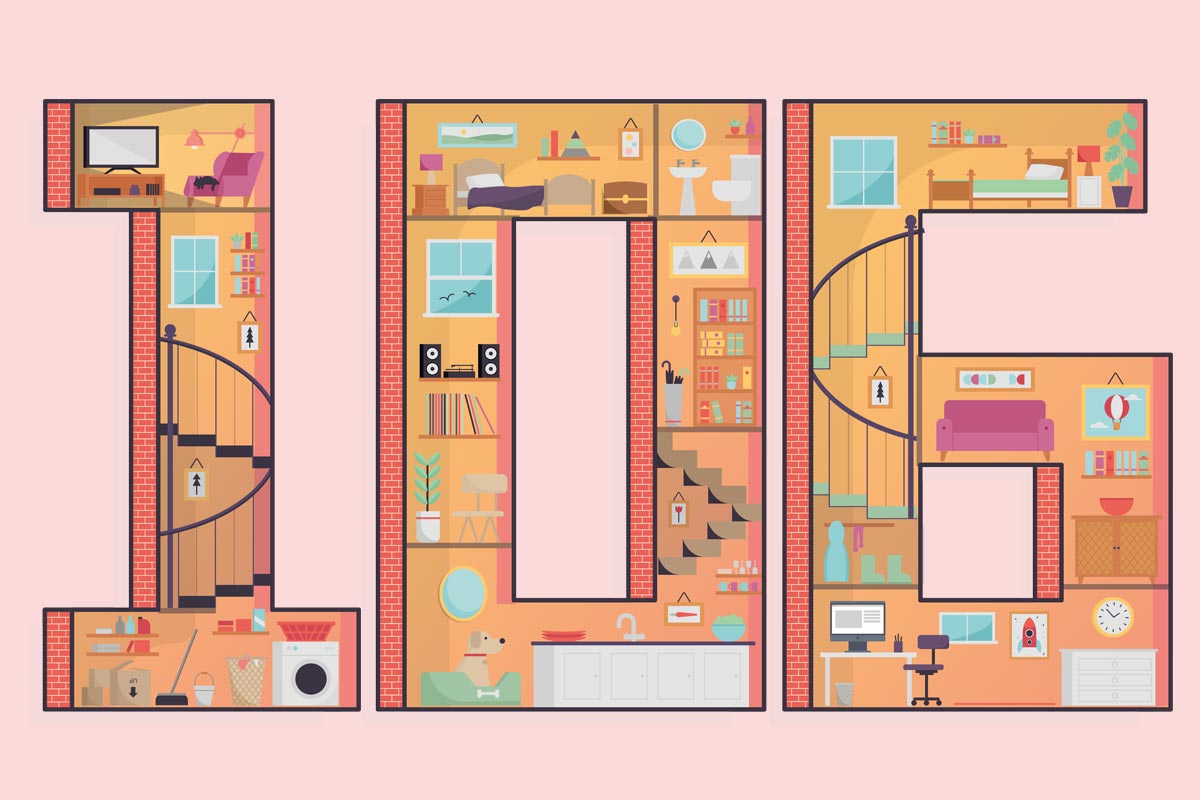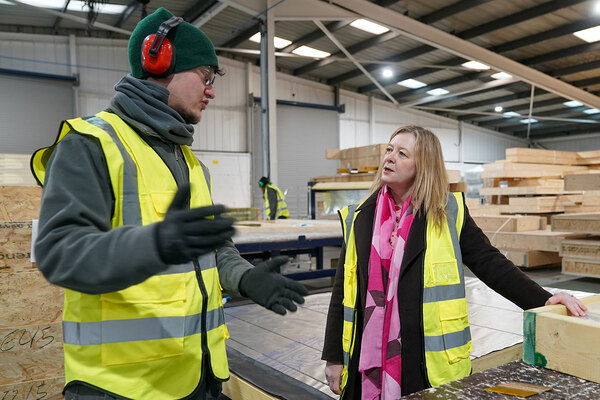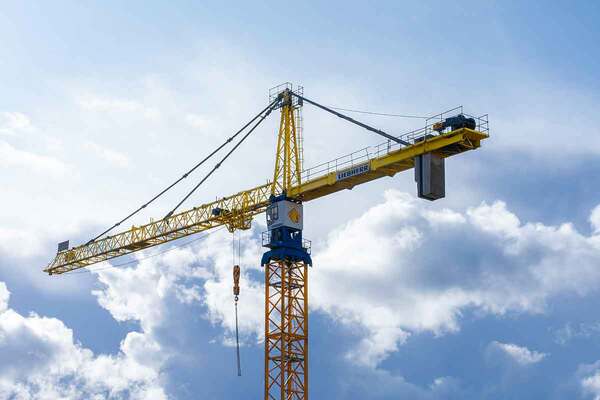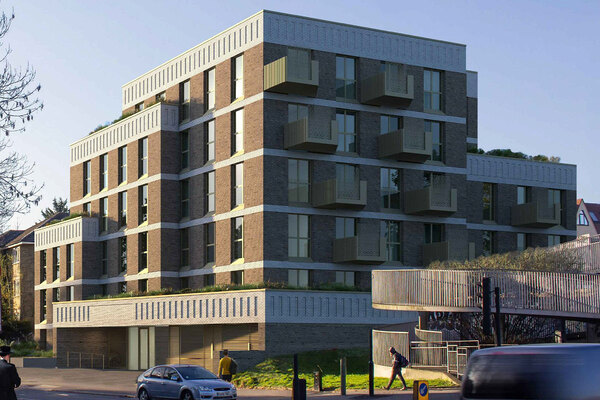You are viewing 1 of your 1 free articles
How much does Section 106 really contribute to affordable housing supply?
Inside Housing’s exclusive data reveals how much of affordable housing is delivered via Section 106. Jess McCabe reports. Illustration by Josh Hurley
If you talk to development directors at housing associations, you will find that Section 106 has an increasingly mixed reputation. Under Section 106, developers have to build a portion of affordable housing as part of their planning permission. On the one hand, this makes a valuable contribution to housing supply, and helps to create mixed-tenure communities. But on the other hand, ask development directors about these homes and you will hear stories of construction standards not being as high and quality control issues.
Earlier this summer, another ‘poor doors’ story hit the headlines. This time, controversy surrounded One Tower Bridge, a luxury block in central London. Social housing tenants living in the building were told their tenancies were at risk if they allowed children to play in common areas. They had already been excluded from communal gardens on the site.
This is just the most recent in a series of similar stories about affordable housing residents – including shared owners and social tenants – being seemingly segregated from private residents in such developments.
This spring, the government was discussing whether to scrap Section 106 altogether and replace it with an infrastructure levy – which would see councils get extra funds to build their own developments instead.
“The residents are less satisfied generally with Section 106 schemes than ones we delivered ourselves. We’ve got data since 2008 to prove that”
But how much does the sector really rely on Section 106 to deliver affordable homes? And what does the future hold?
It is with these questions in mind that we have dug into our exclusive data on housing associations’ development plans.
Room for uncertainty
A total of 49% of the homes completed by housing associations in 2021-22 were acquired via Section 106.
This is according to the full results of our Biggest Builders survey, where we ask 157 of the largest housing associations by number of homes for detailed information on their current and future developments. In total, these associations told us they had built 49,726 homes in 2021-22, and that of these, 19,432 were delivered via Section 106.
Not every association responded to our question about how many homes were delivered through Section 106, so 49% could be an underestimate of the true figure.
But, given that many housing associations have a long-stated desire to reduce their reliance on Section 106, what does the future hold?
As the chart above shows, housing associations told us that in the next two years they expect to deliver more than 114,000 homes – but, at the moment, only 29% of these are firmly expected via Section 106. Of course, there is still substantial room for this to change because housing associations told us they had sites secured for about 47% of the homes they expect to build in the next five years. Nonetheless, some big players are anticipating a shift.
Should it be scrapped?
L&Q delivered the most Section 106 homes of any housing association – more than 2,000 homes, making up 50% of its total delivery.
Yet Vicky Savage, its group development director, told Inside Housing in June: “Going forward, we’ll be doing less Section 106 as we want to do more land-led stuff.”
Percentage of completions that are Section 106 over five years
| Housing association | How many homes do you expect to complete in the next five years (April 2022-March 2027)? | Of these, how many will be Section 106? | Section 106 as a percentage of total completions |
Estuary Housing | 135 | 135 | 100.0% |
Bournville Village Trust | 74 | 74 | 100.0% |
Fairhive1 | 1,052 | 842 | 80.0% |
Origin | 1,287 | 819 | 63.6% |
BPHA | 2,196 | 1,383 | 63.0% |
Aster | 7,782 | 4,694 | 60.3% |
Alliance | 1,070 | 642 | 60.0% |
Bromsgrove | 500 | 300 | 60.0% |
Poplar Harca | 1,517 | 790 | 52.1% |
Citizen | 3,941 | 1,996 | 50.6% |
Source: Inside Housing data
1. Fairhive was formerly Vale of Aylesbury Housing Trust
Consider Plymouth Community Homes (PCH): 75% of the 121 homes it completed in 2021-22 were done so via Section 106.
But Andrew Lawrie, the association’s head of development, is muted at best. “It’s only the last few years there’s been a lot more Section 106 opportunities available. So we made the most of them when they’ve been around. I think we would much prefer land-led development.”
He adds: “We set quite strict minimum Section 106 standards… sometimes we have to pay more to make sure we reach those standards.
Top 10 delivering the most Section 106 homes over five years
Housing association | How many homes do you expect to complete in the next five years? (April 2022-March 2027) | Of these, how many will be Section 106? | Section 106 as a percentage of total completions |
Sovereign | 9,950 | 4,896 | 49.2% |
Aster | 7,782 | 4,694 | 60.3% |
Vivid | 9,700 | 4,519 | 46.6% |
LiveWest | 7,057 | 3,319 | 47.0% |
Abri | 6,230 | 2,672 | 42.9% |
Flagship1 | 4,967 | 2,500 | 50.3% |
Orbit | 6,727 | 2,354 | 35.0% |
Stonewater | 6,327 | 2,100 | 33.2% |
Citizen | 3,941 | 1,996 | 50.6% |
Hyde | 8,500 | 1,700 | 20.0% |
Source: Inside Housing data
1. Flagship’s Section 106 numbers are approximate
“Nevertheless, the residents are less satisfied generally with Section 106 schemes than ones we delivered ourselves. We’ve got data since 2008 to prove that.”
But development directors are wary of proposals to scrap Section 106. The government’s proposals in the spring had not yet been fleshed out, but were expected to see on-site delivery of affordable homes replaced with a levy that could be used in part to fund affordable housing elsewhere.
“Having grant funding available doesn’t guarantee you being able to get land, and trying to get land is the big thing we’re trying to do at the moment, and we haven’t been able to achieve as much as we wanted to,” Mr Lawrie from PCH notes.
Section 106: top 10 percentage of completions
Housing association | Total completions 2021-22 | Of these, how many were Section 106? | Section 106 as a percentage of completions |
Housing Solutions | 93 | 93 | 100.0% |
Estuary Housing | 12 | 12 | 100.0% |
Bournville Village Trust | 7 | 7 | 100.0% |
BPHA | 307 | 289 | 94.1% |
Origin Housing | 125 | 117 | 93.6% |
Saffron | 82 | 73 | 89.0% |
Fairhive1 | 180 | 156 | 86.7% |
Soha Housing | 181 | 151 | 83.4% |
Cross Keys Homes | 286 | 230 | 80.4% |
Sovereign | 1,196 | 945 | 79.0% |
Source: Inside Housing data
1. Fairhive was formerly Vale of Aylesbury Housing Trust
In numbers
49%
Percentage of housing association homes delivered in 2021-22 via Section 106
29%
Percentage of housing association homes that will be delivered through Section 106 over next two years
2,075
Total number of L&Q homes delivered via Section 106 in 2021-22
Sovereign is one of the biggest Section 106 developers – delivering the second-most in absolute number of homes, and being the largest association in the top 10 in terms of proportion of development made up by Section 106. It was 79% in 2021-22, and the association expects Section 106 to make up even more – 85% – of completions in 2022-23.
Yet development director James Gibson says: “Our aim is to move to 50% land-led delivery to enable us to grow and reduce our dependence on both Section 106 and the infrastructure levy.”
Section 106 made up about 76% of Aster Group’s delivery last year, and the 32,700-home association expects it to contribute more than 4,500 homes in the next five years.
Organisations delivering the most homes via Section 106 in 2021-22
Housing association | Section 106 completions 2021-22 | Section 106 as a percentage of total completions |
L&Q | 2,075 | 50.0% |
Sovereign | 945 | 79.0% |
Bromford | 840 | 68.6% |
Clarion | 818 | 35.9% |
Aster | 721 | 76.8% |
Vivid | 658 | 47.0% |
LiveWest | 585 | 64.2% |
Orbit | 508 | 50.1% |
Stonewater | 466 | 55.7% |
Flagship | 435 | 66.4% |
Source: Inside Housing data
Jane Gallifent, its development and sales director, says: “Section 106 is by no means a perfect system, but it does at least create an obligation for affordable development to be ringfenced.”
She adds: “I’m sure that the previous government fully intended to clarify how funding was to be guaranteed under the infrastructure levy. If Ms Truss’ intention is to see through her predecessor’s plan, then she needs to make sure that affordable development is clearly and robustly built into whatever potentially replaces Section 106.”
At present, Section 106 clearly makes up a significant slice of all new homes being delivered. If the Truss government decides to come back to ideas of reforming the policy, the question of what replaces it must be carefully considered.
Sign up for our development and finance newsletter
Already have an account? Click here to manage your newsletters












